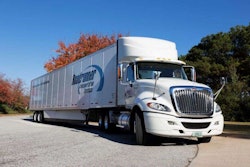
After enduring the same COVID-fueled upheaval as many of its customers, Daimler Trucks North America (DTNA) is on the road to recovery.
In an online media roundup Monday, DTNA president and CEO Roger Nielsen noted 2020 has been a “tough year” but the company is back to building trucks at pre-pandemic levels.
At the height of the pandemic in April, Nielsen said there were nearly 15,000 DTNA employees on furlough. However, those employees are back at work pushing out trucks and he noted the company has already started taking orders for 2021 builds.
Nielsen expects the North American heavy truck market to reach 310,000 vehicles this year, driven by replacement demand of fleet trucks purchased during a strong 2015 buying cycle.
While assembly line employees focus on getting current generation models to customers, DTNA has turned much of its future attention to electrification.
DTNA’s 30-truck Innovation Fleet of battery electric vehicles (BEVs) has logged more than 300,000 miles this year, and Nielsen noted Daimler now has about 1.6 million miles of BEV driving globally.
Via its Innovation Fleet, DTNA provides customers with support in establishing an electric infrastructure, and in exchange uses the carriers’ feedback to refine the trucks’ performance and the driver experience. For example, Nielsen said DTNA is working with customers on how to replicate engine brake activation while the BEV is in cruise control.
“Do they want the truck to coast to 63 mph before the regenerative brake kicks in [if cruise is set at 60 mph], or would they rather the truck go downhill at 60 mph and use the energy they get by it kicking in early to recharge the battery?” he asked.
While the Innovation Fleet is among Freightliner’s earliest BEV adopters, Nielsen and DTNA already have their collective eyes on the future. Freightliner earlier this year announced it would put six heavy-duty Freightliner eCascadias and two medium-duty eM2 106 trucks into its Customer Experience Fleet. J.B. Hunt is now using an eCascadia to deliver intermodal freight for Walmart while Ryder recently took delivery of an eCascadia and an eM2 for placement in its dedicated routes.
DTNA’s electric truck initiative is already more mature than the public charging infrastructure required to support them. To-date, DTNA has helped place about 60 chargers with 7 megawatts of power and another 150 on deck with about 20 megawatts of power.
“I would say the public charging infrastructure isn’t to the point to where you could rely on it as a fleet to supply your fleet with energy on irregular routes,” Nielson said, and noted that DTNA has used passenger car chargers when available to pack more range into the onboard batteries.













